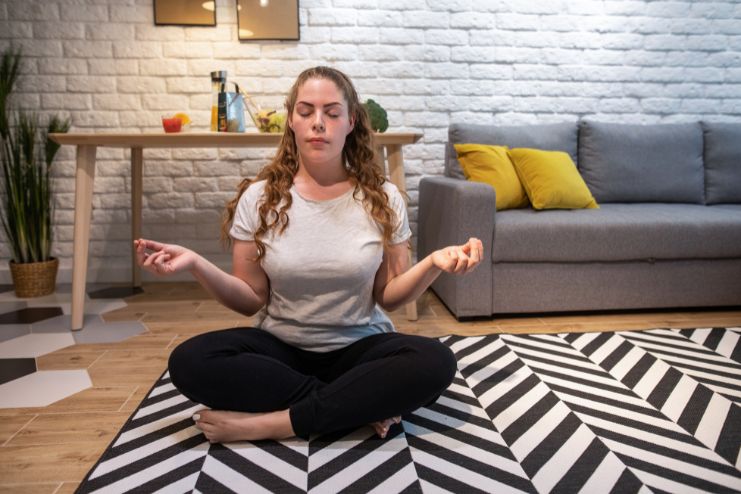Feeling overwhelmed, anxious, or mentally scattered? One of the fastest and most successful tricks for rebooting your mind and body is something you’re already doing—breathing.
But there’s a catch: it’s not just the fact that you’re breathing, but how you’re breathing.
With the use of targeted breathwork, you can lower your heart rate, soothe your mind, and become more centered within minutes.
Breathwork decreases anxiety, relaxes physical tension, and dispels mental fog, creating a sense of calm and mastery when things are out of control. From a stressful day at the office to a restless mind at night, there are easy ways to employ your breath to feel better.
In this article, you’ll learn 7 gentle but powerful breathing techniques that are easy to try and can quickly bring peace to your mind and body, no special tools or training needed.
Read More: 4 Breathing Techniques to Help Burn Fat
Why Breathwork Works: A Quick Science Primer

Your breath has a direct link to your nervous system, which dictates the way your body responds to stress.
Breathwork is not just deep breathing, it’s a powerful, science-proven method for calming the body and mind. Below is a basic description of how it works to decrease stress and improve well-being.
The Autonomic Nervous System: Sympathetic vs. Parasympathetic
Your body has an automatic system responsible for essential processes such as heart rate, breathing, and digestion; it’s known as the autonomic nervous system. This system has two primary components: the sympathetic and parasympathetic nervous systems.
The sympathetic side is your “fight or flight” mechanism. It becomes active when you sense stress or danger and speeds up your heart rate and breathing.
The parasympathetic component is the “rest and digest” mechanism, which relaxes your body and recovers.
Parasympathetic stimulation is the most important factor for unwinding, and breathwork techniques for anxiety are among the quickest means of stimulating this component of the nervous system.
How Breath Regulates Heart Rate, Blood Pressure, and Emotional State
When you’re under stress, your breathing shallows and quickens, raising your heart rate and blood pressure. If you slow your breathing and exhale longer than you inhale, it tells your brain that it’s safe and time to relax.
It drops your heart rate and blood pressure and calms you down. Regular breathwork, done over time, can even improve your circulation and regulate your emotions. It’s like having a reset button for your nervous system at your fingertips. That is why you must apply breathwork to reset your mind at overwhelming moments.
Breathwork expert and founder of The Breath Space, Jamie Clements, says, “One of the most well-documented benefits of daily breathwork is its positive effect on stress and anxiety. It helps shift the nervous system into a more balanced and regulated state.”
The Role of the Vagus Nerve in Calming Responses
One of the biggest contributors to the calming process is the vagus nerve. Your vagus nerve is what links your brain to a lot of your body, including your heart, lungs, and digestive system.
When you slow down and deepen your breathing, you activate your vagus nerve, which increases parasympathetic activation. This slows your heart rate, decreases anxiety, and makes you feel safe. Breathwork for anxiety not only provides rapid relief—its effects last a lifetime, allowing you to build resilience and control over your emotions.
Read More: Top Breathwork For Stress and Longevity
Before You Begin: Setting Up a Safe Space

Before you begin practicing breathwork, it’s necessary to establish a safe, supportive environment in which you can let go completely and tune into your breath. Breathwork is an easy, effortless means of quieting your nervous system, easing stress, and clearing your mind—but the setup matters.
Create a Comfortable Environment
Select a calm, serene area where you will not be interrupted. Position yourself in a comfortable yet upright manner—on a chair with feet planted firmly or on the floor with a cushion. Keep your back straight so that your lungs can expand and fill completely.
This position accommodates deeper breathing, which allows you to calm your nervous system with breathwork more successfully.
Set an Intention, Not a Goal
Come to your breathwork practice with curiosity, not pressure. Rather than attempting to perform each breath or reach a performance target, just observe how you are feeling. Breathwork isn’t a test—any more than brushing your teeth is a test.
Ask yourself: What do I need at this moment? This approach enables you to try breathwork for mental clarity in a gentle, supportive manner.
A Trauma-Informed Reminder
If at any time you become dizzy, anxious, or overwhelmed, stop and go back to your natural breath. Everyone is different when it comes to breathwork, particularly if there’s past trauma or excessive stress involved.
The key is to feel safe and in control. Breathwork should never be forced, it should be just calming and soothing.
Stay Curious, Not Critical
There are days when your breath is smooth and steady, and there are days when your mind gets distracted or your breath is blocked. That’s just fine.
Take every session as an opportunity to discover and learn. Non-judgmental thinking allows you to reap the actual benefits of breathing techniques for stress relief, even on bad days.
Take a moment now to get comfortable. Allow your breath to flow naturally for a few seconds. See how you feel.
From this relaxed beginning, you’re set to explore breathwork and learn how each method can lead you closer to calm, clarity, and balance.
Read More: Nasal Breathing vs Mouth Breathing: Which is Better?
7 Breathwork Techniques for Nervous System Regulation

Breathwork is one of the simplest and most powerful ways to support your emotional and physical well-being. These seven techniques are designed to help calm the mind, balance the body, and regulate your nervous system. Whether you’re new to breathwork or looking to deepen your practice, these methods are easy to follow and highly effective.
1. Box Breathing (4–4–4–4)
This method of breathing is ideal for stress, anxiety, and focus.
- How to do it:Inhale for 4 seconds, hold your breath for 4 seconds, exhale for 4 seconds, and hold again for 4 seconds.
- Repeat for a few minutes, keeping the rhythm steady and calm.
- This practice helps ground you during high-stress situations and promotes breath-based emotional regulation.
2. 4-7-8 Breathing
This technique is especially helpful for sleep, anxiety, and moments of panic.
- How to do it:Inhale through your nose for 4 seconds, hold your breath for 7 seconds, then exhale slowly through your mouth for 8 seconds.
- The long exhale activates the parasympathetic nervous system, helping the body relax.
- Great for winding down at night or resetting after an emotional trigger.
3. Diaphragmatic (Belly) Breathing
Perfect for beginners and those with trauma sensitivities, this technique uses the belly rather than the chest.
- Place one hand on your chest and the other on your belly.
- Breathe in deeply through the nose so your belly rises, then exhale slowly and let it fall.
- This diaphragmatic breathing activates the vagus nerve and supports trauma-informed breathwork and nervous system regulation.
4. Alternate Nostril Breathing (Nadi Shodhana)
Drawn from yogic tradition, this breath balances both hemispheres of the brain.
- Close your right nostril and inhale through the left.
- Then close your left nostril and exhale through the right.
- Inhale through the right, close it, and exhale through the left. That’s one round.
- This method helps balance emotions and clear mental fog, but should be avoided when congested or if it causes dizziness.
5. Coherent Breathing (5–5 Pattern)
A gentle, rhythmic practice that calms the body and mind.
- Inhale for 5 seconds and exhale for 5 seconds, with no pauses in between.
- This even rhythm helps sync your breath with your heart rate, supporting emotional stability.
- Ideal for a daily nervous system “reset” or somatic grounding.
6. Resonance Breathing
A slower, deeper version of coherent breathing that supports heart-brain harmony.
- Aim for about 6 full breaths per minute (roughly 5 seconds in, 5 seconds out).
- Used in clinical and therapeutic settings to build emotional resilience.
- Supports trauma recovery and deeper states of calm.
7. Sighing or Physiological Sigh
Based on research from Stanford, this technique uses a natural breath reset.
- Take a deep inhale (or sigh), then add a second short inhale on top of it.
- Follow with a long, slow exhale.
- This pattern quickly relieves stress, lowers tension, and helps return the body to balance in moments of overwhelm.
These seven nervous system regulation exercises are simple yet powerful tools to help you feel more grounded, centered, and calm—anytime, anywhere. Try one today and let your breath do the healing.
Read More: Top 10 Breathing Support Products
Tips for Practicing Breathwork Consistently

Starting small and staying consistent can make breathwork a powerful tool for everyday calm, clarity, and emotional balance. Here’s how to make it work for you:
Start Small: 2–5 Minutes a Day
- Begin with just a few minutes daily; keep it short and manageable.
- Choose a time that fits naturally into your day (e.g., after waking, during lunch, or before bed).
- Use a timer or a calming app to stay on track.
- Focus on slow, steady inhales and longer exhales to promote nervous system regulation.
Use Everyday Moments as Reminders
- Practice after emotional triggers like arguments, deadlines, or overwhelm.
- Use breathwork as a transition tool—after work, before bed, or during stressful tasks.
- Turn waiting times (e.g., in traffic or queues) into moments for mindfulness breathing practice.
- Try vagus nerve breathing techniques that include extended exhales to calm quickly.
Pair Breath with Other Grounding Tools
- Combine with touch—place a hand on your heart or belly for diaphragmatic breathing.
- Add sound—play soft music or use nature sounds to relax deeper.
- Use gentle movement—try swaying, stretching, or walking while breathing.
- Light a candle or use aromatherapy to engage your senses and enhance the ritual.
Make It Your Own
- Choose techniques that feel natural—there’s no perfect way to breathe.
- Personalize your space with comforting objects, lighting, or scents.
- Don’t worry about “getting it right”—curiosity is more important than control.
- Over time, build your own mix of deep breathing exercises that suit different moods or needs.
Practicing breathwork regularly—even in short bursts—can become one of your most reliable nervous system regulation exercises, helping you stay grounded, focused, and emotionally resilient.
Lung HelpLine respiratory therapist Mark Courtney advises starting these breathing exercises when you’re feeling okay, not when you’re already short of breath. “They might look simple, but they take practice,” he says. “Get comfortable with them first, and then use them during breathlessness. Aim to practice both exercises for about 5 to 10 minutes each day.”
Read More: How to Breathe While Running?
When Breathwork Feels Uncomfortable

Although breathwork is a potent intervention for calm, healing, and breath-based emotional regulation, at times it may feel intense or even disturbing, particularly for individuals with a trauma history, anxiety, or dissociation.
These sensations are real and more prevalent than you may realize.
Breathwork Can Feel Intense—And That’s Okay
For survivors of trauma or individuals who have dissociation, working with the body using breath can be overwhelming. Deep breathing may bring up feelings or memories that have been stored away for a long time.
This is not an indication that something has gone wrong—this is part of healing. When this is the case, trauma-informed breathwork provides a more gentle, safer route.
Know When to Pause
Some indications that it is time to back off or stop are:
- Dizziness or lightheadedness
- Numbness or tingling in the face or extremities
- Feeling overwhelmed, panicked, or disconnected emotionally
If this occurs, gently return to your natural breath. Utilize somatic grounding—like noticing your feet touching the floor, putting your hand on a soft object, or identifying five things you can see—to assist with bringing yourself into the present.
Make Simple Adjustments
You may adjust your practice of breathwork so it is more nourishing by:
- Slowing your breathing rate and reducing the practice time
- Practicing diaphragmatic breathing or gentle vagus nerve breathing
- Utilizing grounding tools such as soft music, aromas, or movement
- Seated or lying down in a position that feels safe
- Being mindful of your body’s cues and making adjustments
These modifications make breathwork a safe method of breath-based emotional regulation even on difficult days.
Seek Support When Needed
If frequent discomfort persists, try seeing a practitioner who has trained in trauma-informed breathwork. They can walk you through practices designed to support your specific needs and help you develop resilience on your own timeline.
In some instances, trauma recovery breathwork combined with professional care can result in permanent emotional healing and nervous system equilibrium.
Keep in mind, breathwork is a personal journey. Slow is fine, breaks are fine, and modifying the practice is fine too. With kindness and compassion, breathwork can be a wonderful support in your healing and self-regulation process.
Read More: Treatment for Anxiety Breathing
Final Thoughts

Your breath is always with you, so is the power to control your emotions and soothe your nervous system. In times of stress, overwhelm, or emotional distress, a few slow, conscious breaths can assist you in moving into a more balanced, grounded state.
These practices are simple but effective tools for emotional health and mental clarity. Breathwork gently helps your body transition from stress to relaxation by stimulating the vagus nerve and regulating the nervous system.
The thing to remember is to begin small, be consistent, and let your body take the lead. Whether you are employing deep breathing exercises, diaphragmatic breathing, or simply slowing down to observe your inhale and exhale, with each breath, you are creating emotional resilience.
No hurry, no perfection necessary. Ready to get started? Select one breath exercise today and commit to it for only two minutes. Your body—and mind—will be grateful.
References
- https://www.nhs.uk/mental-health/self-help/guides-tools-and-activities/breathing-exercises-for-stress/
- https://www.betterhealth.vic.gov.au/health/healthyliving/breathing-to-reduce-stress
- https://www.calm.com/blog/how-to-calm-nerves
- https://www.nature.com/articles/s41598-022-27247-y
- https://www.nationalgeographic.com/health/article/health-benefits-of-breathing-exercises
- https://www.uow.edu.au/media/2024/what-is-breathwork-and-do-i-need-to-doit.php
- https://positivepsychology.com/deep-breathing-techniques-exercises/
- https://www.everydayhealth.com/alternative-health/living-with/ways-practice-breath-focused-meditation/
- https://www.bhf.org.uk/informationsupport/heart-matters-magazine/wellbeing/breathing-exercises
- https://www.wimhofmethod.com/breathing-exercises
- https://psychcentral.com/lib/change-how-you-feel-change-how-you-breathe
- https://www.verywellmind.com/holotropic-breathwork-4175431
- https://www.othership.us/resources/breathwork-side-effects
In this Article




![Best NAD+ Supplements for Energy, Aging, and Cellular Health [2025 Edition] Best NAD+ Supplements for Energy Aging](https://www.healthspectra.com/wp-content/uploads/2025/05/Best-NAD-Supplements-for-Energy-Aging-218x150.jpg)












